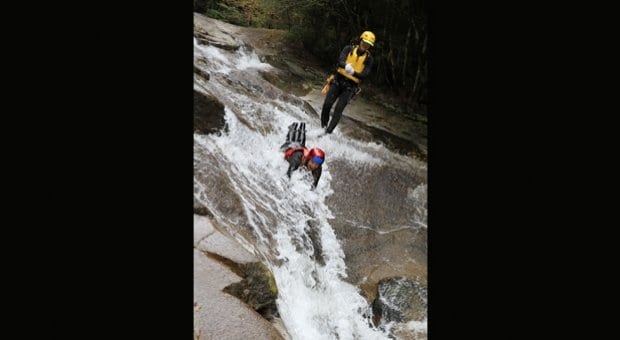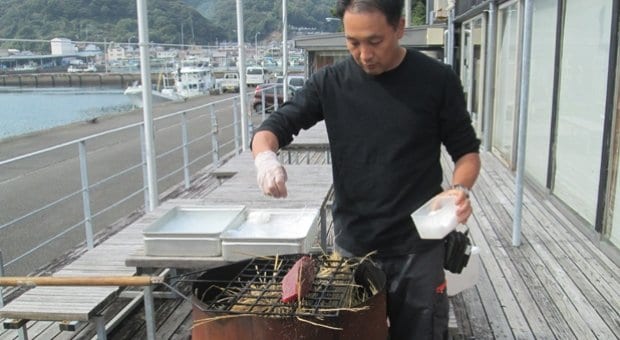
Suspension bridge nestled in Iya Valley's tree-covered mountains. Credit: LoAnn Halden

Kochi Castle Credit: LoAnn Halden

Don a wetsuit, crash helmet and special pads for canyoning in Nametoko gorge. Credit: Patrick Lau
Taking a flight south from Honshu, Tokyo’s island home, to Shikoku, the smallest and least populated of Japan’s four main islands, is like stepping into a time machine. In Tokyo, the future crackles in neon-bedazzled neighbourhoods and bullets down rail lines. In Shikoku, agriculture and fishing keep the economy meandering along; traditional Japanese wooden architecture, nature trails and onsens (hot springs/public baths with accompanying inns) accent the landscape’s quiet beauty. It was 1988 before the first of three bridges connected Shikoku to the mainland.
Go to Tokyo to sample Japan’s LGBT culture (the city has upwards of 250 gay bars), but go to Shikoku for a lesson in graciousness to travellers of all kinds. The island is most famous for its 88-temple Buddhist pilgrimage route associated with the monk Kobo Daishi. Although English isn’t commonly spoken on the island, the presence of dedicated hikers and cyclists covering the 1,200-kilometre temple circuit translates into genuine camaraderie between locals and international visitors.
Architecture & Adventure
Shikoku is divided into a quartet of prefectures — Tokushima, Ehime, Kochi and Kagawa — serviced by rail (japanrailpass.net). Bus tours offer an overview of the island’s temples if self-propulsion isn’t in the travel plan. Regardless of transport, the most popular route begins with the first temple, Ryozenji in Tokushima. Canadian David Moreton, a locally based expert on the Shikoku Pilgrimage, offers guide services, books and maps in English (davidmoreton.com).
But it’s not just about the temples. Tokushima’s interior is home to Wakimachi, a national preservation area that showcases architecture with the high-wingedudatsu walls that adorned wealthy merchants’ houses during the Edo period (early 1600s–1868); in Iya Valley — particularly stunning when its tree-covered mountains blaze in fall colour — the air is so fresh, it’s effervescent. Iya-no-Kazurabashi, a 45-metre-long suspension bridge made of vines, spans the gorge; walking its rustic planks feels like stepping into an Indiana Jones movie. Kochi Castle, in the prefecture of the same name, is one of only 12 castles in Japan with its original stone walls and wooden gates intact.
Japan might not have a warm and fuzzy reputation when it comes to marine life, but the Osaka Aquarium Biological Research Institute in Iburi tells a different story: reclusive whale sharks, the sea’s largest fish, are a focal point of the centre’s studies. These speckled plankton feeders are the stars of its 3,300-ton tank, and in summer months, it’s possible to swim with them. Designated Japan’s first underwater park in 1970, Tatsukushi Marine Park offers glass-bottom boat trips over coral gardens to the otherworldly sandstone cliffs of the Minokoshi Coast. (Both are in Kochi prefecture.)
Nametoko Gorge (in Ehime), a tranquil hiking area, is now also ground zero for the wacky adventure sport of canyoning. Don a wetsuit, crash helmet and special pads courtesy of Forest Canyon outfitters to slide down the river’s narrow rapids sans raft; the ravine is filled with natural water chutes. Located in Ehime’s capital city, Matsuyama, Dogo Onsen is not only one of the country’s oldest hot springs, but its Meiji-period public bathhouse (built in 1894) has a long history of aristocratic guests and allegedly inspired Hayao Miyazaki’s anime classic Spirited Away.
Eat
Even the most deceptively simple dishes burst with flavour on Shikoku, thanks to the abundance of fresh, local ingredients. Sashimi from river fish rivals ocean counterparts, and chicken in Tokushima will silence anyone who has ever deemed poultry flavourless. Transforming stoneground buckwheat flour into soba noodles has been an Iya tradition for centuries, while ramen is the specialty in Tokushima. Other must-tries: katsuo no tataki (bonito, lightly seared over rice stalks — a cooking method that originated in what is now Kochi prefecture) and bite-sized fried river shrimp.
Stay
Western rooms on the island offer familiar creature comforts, but the Japanese-style ryokan — with their tatami floors, futon beds, communal baths and local cuisine — deliver authenticity. The Iya Valley has top-notch hot springs resorts, including the Iya Onsen hotel (iyaonsen.co.jp/english), with a cable car that transports guests to open-air baths at the bottom of the ravine. For a completely immersive experience, Chiiori Trust (chiiori.org) arranges stays in a beautifully restored 300-year-old thatched-roof mountain home in the eastern Iya Valley.
Resources
Hiromi Thetreau
twobearstravel.com
Out Asia Travel
outasiatravel.com
Tourism Shikoku
tourismshikoku.org
For the most up-to-date travel information on gay Tokyo, see our City Guide, Listings Guide, Events Guide and Activities Guide.

 Why you can trust Xtra
Why you can trust Xtra